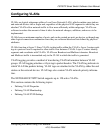
FS728TP Smart Switch Software User Manual
Configuring the Device Using Your Browser 5-68
v2.0, November 2006
Configuring VLANs
VLANs are logical subgroups within a Local Area Network (LAN), which combine user stations
and network devices into a single unit, regardless of the physical LAN segment to which they are
attached. VLANs allow network traffic to flow more efficiently within subgroups. VLANs use
software to reduce the amount of time it takes for network changes, additions, and moves to be
implemented.
VLANs have no minimum number of ports, and can be created per unit, per device, or through any
other logical connection combination since they are software-based and not defined by physical
attributes.
VLANs function at Layer 2. Since VLANs isolate traffic within the VLAN, a Layer 3 router work-
ing at a protocol level is required to allow traffic flow between VLANs. Layer 3 routers identify
segments and coordinate with VLANs. VLANs are Broadcast and Multicast domains. Broadcast
and Multicast traffic is transmitted only in the VLAN in which the traffic is generated.
VLAN tagging provides a method of transferring VLAN information between VLAN
groups. VLAN tagging attaches a 4-byte tag to packet headers. The VLAN tag indicates to
which VLAN the packets belong. VLAN tags are attached to the VLAN by either the end
station or the network device. VLAN tags also contain VLAN network priority informa-
tion.
The NETGEAR FS728TP Switch supports up to 128 active VLANs.
This section contains the following topics:
• Defining VLAN Properties
• Defining VLAN Membership
• Defining VLAN PVID Settings


















